Jan 2006 Expedition to Chile and Argentina
Travelogue:
On 4 Jan 2006 we left Paradise (Wanaka NZ) for five weeks in Chile and Argentina. We have put together a few photos with some notes to help you understand why we now spend a lot of our time raving about Santiago, Buenos Aires, Patagonia and Iguazu Falls. We travelled Wanaka > Auckland > Santiago > Buenos Aires (BA) > Bariloche (Lakes District) > Puerto Varas (Chile - near Osorno) > Puerto Montt > Punta Arenas (bottom of Chile) > Puerto Natales > Torres del Paine National Park > El Calafate (Argentina) > Moreno Glacier > El Chalten, Cerro (Mt) Fitz Roy and Cerro Torre > El Calafate > Ushuaia (Tierra del Fuego) > BA > Iguazu Falls > BA > Auckland > Wanaka. The map locates many of our destinations while the following photos follow our itinerary.
Left click map and photos to enlarge:

Santiago - three days in Chile's capital which is like a modern European city with a strong Spanish flavour. The downtown has two very large pedestrian malls linked by many arcades in which you will often find like shops grouped together (eg, 14 hair salons side by side - very competitive). Chilians love icecream almost as much as Kiwis and there are many 'icecream restaurants' which serve large varieties of icecream. Being typical Chilians the Santiagans were smiling, friendly people in the middle of electing their first woman president, Michelle Bachelet, who was imprisoned and tortured by Pinochet.

Senora Martin relaxing in the cool, green Cerro (Mt) Santa Lucia park, with its own waterfall, near the downtown area.

The waterfall. Very cooling as it was mid 30s. Santiago lies in a rainshadow about 45km from the Andes.
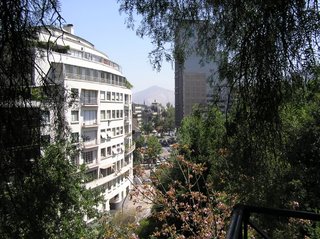
The new, the old and the Pepperina trees. Since its founding in 1541 the city has lost many buildings to earth quakes.
Buenos Aires - two days on arrival and then three days on our return from Patagonia in Argentina's capital which is like a modern, slightly run down European city with a strong Spanish flavour. Like Santiago, the city has a downtown with two very large pedestrian malls linked by many arcades, dominated by shops selling leather goods, tango dancers in the streets, and restaurants specialising in meat dishes (Parrillas). While the menu always includes beef (half a kilo minimum), lamb and chicken they almost always have fish and vegetables as well. It was in Buenos Aires that we met up with our fellow travellers (eleven in all including us and our guide Maria Augusta Obando). From Buenos Aires we flew to Bariloche and started the Patagonian leg of our expedition.

If you want it in leather then Buenos Aires has it - leather dresses, leather bags...
San Carlos de Bariloche - by plane from BA - four days including an 8 km bike ride from the Catedral ski resort to Llao-Llao along Lago (lake) Perito Morneo, and an 8 hour hike up to Refugio Frey, a popular rock climbing area. Bariloche is a little like Queenstown - on the shores of a very large lake surrounded by high mountians - but with a heavy German/Swiss influence on the houses and gardens.

Villa Catedral - the ski resort from which we started our bike ride to Llao Llao and our hike to Refugio Frey.

The bikers on the shores of Lago Perito Moreno.

Snack break at the Colonia Suiza camping ground.

Lunch - wine, fruit juice, steaks, sausages, bread rolls, cold meats, cheese, fruit, yummm.

Yummmm!
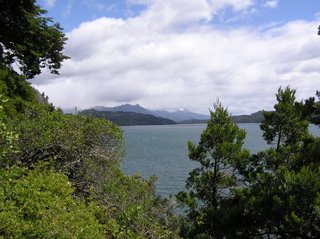
Lago Perito Moreno.

Hotel Llao Llao - end of the ride. From here we local bused back to Bariloche.

Hiking through the beech forest to Refugio Frey - 8 hours return.

Slippery when wet.
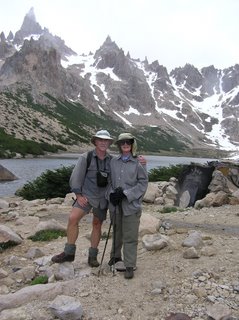
Refugio Frey is to the right, with good coffee, hot food and dormatory accommodation for the climbers. Many climbers were also camping along the lake shore. This walk is part of a four day circuit which takes you to two
other refuges with views across to Cerro Tronador (3491 metres).
Puerto Varas and the Osorno Volcano - by bus through the Chilean/Argentinian Lakes District along Lago Nahuel Huapi and across the border into Chile and the Puyehoe NP. Lots of blue/green lakes, rivers, mountains and beech forests until you reach the volcano country and Puerto Varas on the shores of Lago Llanquihue. Dominating the lake is Volcan Osorno at 2652 metres. Nearby are the spectacular Salto del Petrohue
rapids.

Volcan Osorno from Puerto Varas.

A dusky moon over Lago Llanquihue and Volcan Osorno. Our hotel was nearby.

Breakfast at Hostal Klein where the German speaking senora started breakfast with a homemade sweet tart entree, followed by ham, cheese, bread, jam, fresh plum juice and coffee.


We bused to the volcano and walked up to the snow line with views across the lake to Volcan Calbuco.
![]()
![]()
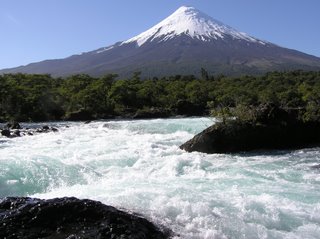
From the volcano we walked across old lava fields and then bused to the Rio Petrohue and the Saltos del Petrohue falls.
 The Rio Petrohue is a thunderous wild, wild river which runs from Lago Todos Los Santos to Lago Llanquihue. The falls are quite extensive and are very easy to access via a series of walkways and bridges.
The Rio Petrohue is a thunderous wild, wild river which runs from Lago Todos Los Santos to Lago Llanquihue. The falls are quite extensive and are very easy to access via a series of walkways and bridges.
Paine NP (Chile) - from Puerto Varas we bused to Puerto Montt and then flew about 600km south to Punta Arenas where we visted a penguin colony. The following day we bused to Puerto Natales and began our seven day adventure into Torres Del Paine, one of mountaineering's great shrines.

Day Zero - Puerto Natales - our only experience of the infamous Patagonian winds which often dominate many trips.

Eduardo, our guide for the next 7 days. The Chilian version of Mister Masala - madness at its best.
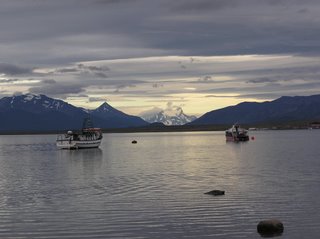
Day Zero - Puerto Natales with Cerro Paine Grande on horizon. We camped below her on the end of Day One.

Day One - small seal colony in a cave on the Seno (Sound) de Ultima Esperanza enroute by boat (3 hours) to Glacier Serrano.
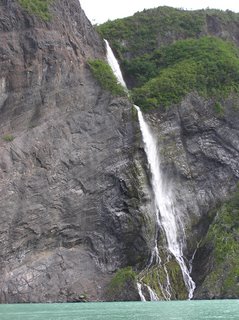
One of many waterfalls falling into the teal coloured waters of the Sound.

At last a view of the Paine massif, although still 5 hours away.

At the head of the Sound is Glacier Belmaceda, and...

...Glaciar Serrano and the Troops. We then took a 3 hour zodiac trip up the Rio Serrano to the Rio Serrano campground.

Kitting up for the zodiac ride. Dawn with the raised arms. From the camping area we bused and boated to Refugio Paine Grande.

Enroute along Lago Pehoe to Refugio Paine Grande with the black capped cuernos (horns) of Paine - Cuerno Norte, and Cuerno Central and Cuerno Este separated by the u-shaped pass.

From the left - toilet and shower block, "mess" room, and the Refugio Paine Grande. Our tents are near the blue cooking tent and yellow mess tent in top middle of photo.
.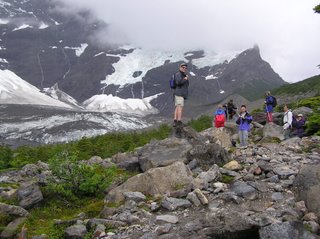
Day Two - 9 hour walk up into the Valle del Frances (French Valley) and the Glaciar Frances.

Cuerno Central (2600m) and Cuerno Esta (2200m).

Avalanche cascading onto Glaciar Frances.
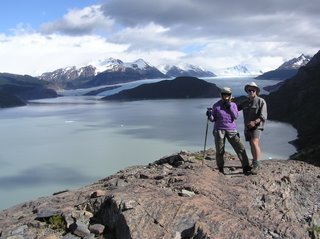
Day Three - 4 hours to Refugio Grey and Glaciar Grey. The Refugio is on the bay on the right.

Day Four - Zodiaced across to the left tongue of the glacier for a little light glacier walking and ice climbing .

Dawn bags the East Face of the Grey cravasse.

Day Five - boated along the Glaciar Gray and up Lago Gray to Hosteria Lago Gray and then bused to Hosteria Las Torres.

View across Lago Pehoe enroute to Hosteria Las Torres.
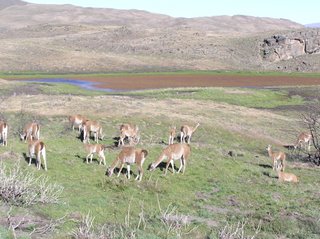
Guanacos beside the road to Hosteria Las Torres. These little fluffas are similar to alpacas.
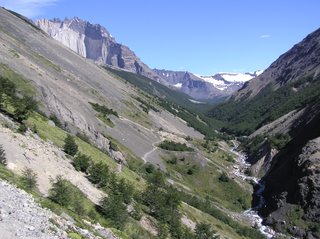
Day Six - 8 hour walk to the Torres del Paines (Towers of Paine) along the Valle Ascencio.

Torres del Paines - from the left - Torre Martin (1111m - bagged by the Martin Expedition in 2006), Torre D'Agostini (or Torre Sur - 2850m - bagged by the Italians in 1963), Torre Central (2800m - bagged by the Poms Don Whillans and Chris Bonington in 1963) and Torre Monzino (or Torre Norte - 2600m - bagged by the Italians in 1958).
El Calafate and the Moreno Glacier (Argentina) - The next day we bused north across the border into Argentina to El Calafate and the Moreno Glacier. El Calafate is on the shores of Lago Argentino and is about the size of Wanaka. The surrounding countryside (the Stepps) is very dry and similar to Central Otago. You take a one hour bus ride to the Moreno Glacier which is stable and a World Heritage site.

Glaciar Moreno.

Glaciar Moreno.

Glacier Moreno.

Glacier Moreno - the tourist boat gives you some idea of the size of the glacier.

We took the boat which takes you to within 200m of the ice cliffs that rise about 60m above the lake.
El Chalten , Cerro Torre, Cerro Egger and Monte Fitzroy - Next stop was the small mountain town of El Chalten, about 5 hours north of El Calafate over a very rough dirt road through the dry stepp country along side the mighty Rio La Leona which links Lago Viedma and Lago Argentino.

Hotel La Leona - half way between El Calafate and El Chalten. Like something out of a wild west film.

El Chalten.

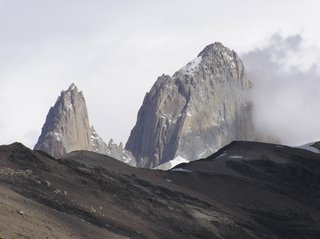
Cerro Poincenot and Monte Fitzroy (on the right - 3405m)

Climbing heaven - Cerro Torre and Cerro Egger up there in the clouds. Better luck next time!
Ushuaia and Tierra del Fuego (Land of Fire) - We bused from El Chalten to El Calafate and then flew about 900km south east to Ushuaia which is the port used by many of the boats heading south to Antartica. Ushuaia is a city of about 25000 and lies at the head of Bahia de Ushuaia (Ushuaia Bay). The bay feeds into the the Canal Beagle (Beagle Channel) that, along with the Estrecho de Magallanes (Straits of Magallane) about 70km to the north, provides a safe route for ships moving to and from the Atlantic and Pacific oceans, avoiding the treacherous journey around Cabo de Hornos (Cape Horn). We took a 4 hour boat trip out into the Channel and stopped off on a small island. The day time temperature over our 3 day visit was around zero to five degrees.
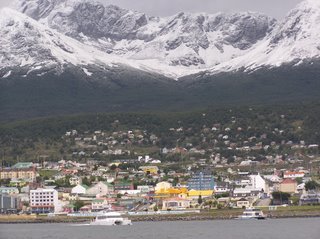
Ushuaia with fresh snow on the Montes Martial (about 1600m high).

We took a boat out into the Beagle Channel and found...

an island of cormorants,
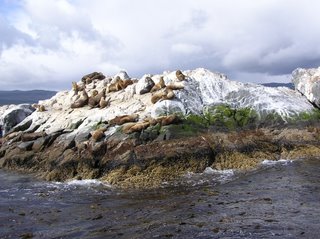
sea lions on a small rock outcrop, and

from a small island reserve a view across Bahia de Ushuaia to the Sierra Sorondo with Ushuaia to the right.
Cataratas del Iguazu (Iguazu Falls) - From Ushuaia we flew to BA and said goodbye to our fellow travellers - a wonderful easy going group whose love of the mountains (and good food, wine and adventure) matched ours. BA was in the mid 30s and humid. Two days later we were in tropical Iguazu, about 1000km north of BA, for 3 days with the temperature in the mid 40s and very, very humid. Not that we noticed as we found ourselves in one of the most wonderous sites we have ever experienced. At last count the Rio Iguazu was roaring over 275 waterfalls, many up to 80m high, stretching about 2.5km along the edge of a basalt plateau. As Lonely Planet says "...even the most hardened of waterfall yawners will be taken aback by the Iguazu falls. ...the power, size and sheer noise of the falls are truly spectacular". You can get right on top of or at the bottom of most of the falls via a system of walkways, and you can take a highly recommended zodiac boat ride up the Rio Iguazu to the base of some of the falls, getting close enough to be drenched and deafened by the falling water.

The map should help locate the following shots.

Looking up the Rio Iguazu towards the Brazilian side of the Falls and the Garganta del Diablo (the Devil's Throat). Note the zodiac nosing into the Salto Tres Mosqueteros (the 3 mosquitos falls).

Our zodiac waiting to nose into Salto San Martin (on the left, of course).
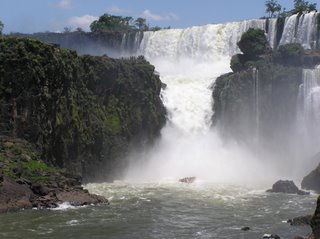
It was wet, it was deafening, and bloody great fun - the zodiac nuzzling Salto San Martin.

Senora Martin looking across the top of Salto San Martin.

Salta Dos Hermanas (two brothers).
The Iguazu Falls lie in a world heritage national park which has around two million visitors a year and is very well maintained.
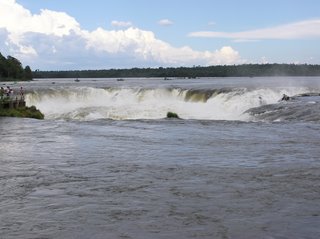
The mouth of the Devil's Throat (Garganta del Diablo).

The Devil's..

...Throat.

Our room with a view of the Devil's Throat
Five days later we were home in Wanaka and reunited with our babies who had been spoiled rotten by their Cousin Carol.
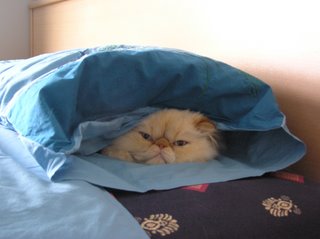
Spoilt Cat Number One - M. Zirabeau loves his pillow case.
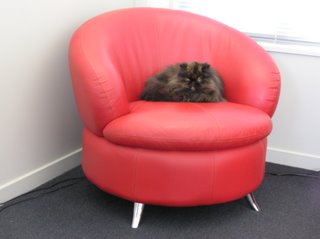
Spoilt Cat Number Two - the very chic Mlle. Zelysees loves her red leather chair.
On 4 Jan 2006 we left Paradise (Wanaka NZ) for five weeks in Chile and Argentina. We have put together a few photos with some notes to help you understand why we now spend a lot of our time raving about Santiago, Buenos Aires, Patagonia and Iguazu Falls. We travelled Wanaka > Auckland > Santiago > Buenos Aires (BA) > Bariloche (Lakes District) > Puerto Varas (Chile - near Osorno) > Puerto Montt > Punta Arenas (bottom of Chile) > Puerto Natales > Torres del Paine National Park > El Calafate (Argentina) > Moreno Glacier > El Chalten, Cerro (Mt) Fitz Roy and Cerro Torre > El Calafate > Ushuaia (Tierra del Fuego) > BA > Iguazu Falls > BA > Auckland > Wanaka. The map locates many of our destinations while the following photos follow our itinerary.
Left click map and photos to enlarge:

Santiago - three days in Chile's capital which is like a modern European city with a strong Spanish flavour. The downtown has two very large pedestrian malls linked by many arcades in which you will often find like shops grouped together (eg, 14 hair salons side by side - very competitive). Chilians love icecream almost as much as Kiwis and there are many 'icecream restaurants' which serve large varieties of icecream. Being typical Chilians the Santiagans were smiling, friendly people in the middle of electing their first woman president, Michelle Bachelet, who was imprisoned and tortured by Pinochet.

Senora Martin relaxing in the cool, green Cerro (Mt) Santa Lucia park, with its own waterfall, near the downtown area.

The waterfall. Very cooling as it was mid 30s. Santiago lies in a rainshadow about 45km from the Andes.

The new, the old and the Pepperina trees. Since its founding in 1541 the city has lost many buildings to earth quakes.
Buenos Aires - two days on arrival and then three days on our return from Patagonia in Argentina's capital which is like a modern, slightly run down European city with a strong Spanish flavour. Like Santiago, the city has a downtown with two very large pedestrian malls linked by many arcades, dominated by shops selling leather goods, tango dancers in the streets, and restaurants specialising in meat dishes (Parrillas). While the menu always includes beef (half a kilo minimum), lamb and chicken they almost always have fish and vegetables as well. It was in Buenos Aires that we met up with our fellow travellers (eleven in all including us and our guide Maria Augusta Obando). From Buenos Aires we flew to Bariloche and started the Patagonian leg of our expedition.

If you want it in leather then Buenos Aires has it - leather dresses, leather bags...
San Carlos de Bariloche - by plane from BA - four days including an 8 km bike ride from the Catedral ski resort to Llao-Llao along Lago (lake) Perito Morneo, and an 8 hour hike up to Refugio Frey, a popular rock climbing area. Bariloche is a little like Queenstown - on the shores of a very large lake surrounded by high mountians - but with a heavy German/Swiss influence on the houses and gardens.

Villa Catedral - the ski resort from which we started our bike ride to Llao Llao and our hike to Refugio Frey.

The bikers on the shores of Lago Perito Moreno.

Snack break at the Colonia Suiza camping ground.

Lunch - wine, fruit juice, steaks, sausages, bread rolls, cold meats, cheese, fruit, yummm.

Yummmm!

Lago Perito Moreno.

Hotel Llao Llao - end of the ride. From here we local bused back to Bariloche.

Hiking through the beech forest to Refugio Frey - 8 hours return.

Slippery when wet.

Refugio Frey is to the right, with good coffee, hot food and dormatory accommodation for the climbers. Many climbers were also camping along the lake shore. This walk is part of a four day circuit which takes you to two
other refuges with views across to Cerro Tronador (3491 metres).
Puerto Varas and the Osorno Volcano - by bus through the Chilean/Argentinian Lakes District along Lago Nahuel Huapi and across the border into Chile and the Puyehoe NP. Lots of blue/green lakes, rivers, mountains and beech forests until you reach the volcano country and Puerto Varas on the shores of Lago Llanquihue. Dominating the lake is Volcan Osorno at 2652 metres. Nearby are the spectacular Salto del Petrohue
rapids.

Volcan Osorno from Puerto Varas.

A dusky moon over Lago Llanquihue and Volcan Osorno. Our hotel was nearby.

Breakfast at Hostal Klein where the German speaking senora started breakfast with a homemade sweet tart entree, followed by ham, cheese, bread, jam, fresh plum juice and coffee.


We bused to the volcano and walked up to the snow line with views across the lake to Volcan Calbuco.

From the volcano we walked across old lava fields and then bused to the Rio Petrohue and the Saltos del Petrohue falls.

Paine NP (Chile) - from Puerto Varas we bused to Puerto Montt and then flew about 600km south to Punta Arenas where we visted a penguin colony. The following day we bused to Puerto Natales and began our seven day adventure into Torres Del Paine, one of mountaineering's great shrines.

Day Zero - Puerto Natales - our only experience of the infamous Patagonian winds which often dominate many trips.

Eduardo, our guide for the next 7 days. The Chilian version of Mister Masala - madness at its best.

Day Zero - Puerto Natales with Cerro Paine Grande on horizon. We camped below her on the end of Day One.

Day One - small seal colony in a cave on the Seno (Sound) de Ultima Esperanza enroute by boat (3 hours) to Glacier Serrano.

One of many waterfalls falling into the teal coloured waters of the Sound.

At last a view of the Paine massif, although still 5 hours away.

At the head of the Sound is Glacier Belmaceda, and...

...Glaciar Serrano and the Troops. We then took a 3 hour zodiac trip up the Rio Serrano to the Rio Serrano campground.

Kitting up for the zodiac ride. Dawn with the raised arms. From the camping area we bused and boated to Refugio Paine Grande.

Enroute along Lago Pehoe to Refugio Paine Grande with the black capped cuernos (horns) of Paine - Cuerno Norte, and Cuerno Central and Cuerno Este separated by the u-shaped pass.

From the left - toilet and shower block, "mess" room, and the Refugio Paine Grande. Our tents are near the blue cooking tent and yellow mess tent in top middle of photo.
.

Day Two - 9 hour walk up into the Valle del Frances (French Valley) and the Glaciar Frances.

Cuerno Central (2600m) and Cuerno Esta (2200m).

Avalanche cascading onto Glaciar Frances.

Day Three - 4 hours to Refugio Grey and Glaciar Grey. The Refugio is on the bay on the right.

Day Four - Zodiaced across to the left tongue of the glacier for a little light glacier walking and ice climbing .

Dawn bags the East Face of the Grey cravasse.

Day Five - boated along the Glaciar Gray and up Lago Gray to Hosteria Lago Gray and then bused to Hosteria Las Torres.

View across Lago Pehoe enroute to Hosteria Las Torres.

Guanacos beside the road to Hosteria Las Torres. These little fluffas are similar to alpacas.

Day Six - 8 hour walk to the Torres del Paines (Towers of Paine) along the Valle Ascencio.

Torres del Paines - from the left - Torre Martin (1111m - bagged by the Martin Expedition in 2006), Torre D'Agostini (or Torre Sur - 2850m - bagged by the Italians in 1963), Torre Central (2800m - bagged by the Poms Don Whillans and Chris Bonington in 1963) and Torre Monzino (or Torre Norte - 2600m - bagged by the Italians in 1958).
El Calafate and the Moreno Glacier (Argentina) - The next day we bused north across the border into Argentina to El Calafate and the Moreno Glacier. El Calafate is on the shores of Lago Argentino and is about the size of Wanaka. The surrounding countryside (the Stepps) is very dry and similar to Central Otago. You take a one hour bus ride to the Moreno Glacier which is stable and a World Heritage site.

Glaciar Moreno.

Glaciar Moreno.

Glacier Moreno.

Glacier Moreno - the tourist boat gives you some idea of the size of the glacier.

We took the boat which takes you to within 200m of the ice cliffs that rise about 60m above the lake.
El Chalten , Cerro Torre, Cerro Egger and Monte Fitzroy - Next stop was the small mountain town of El Chalten, about 5 hours north of El Calafate over a very rough dirt road through the dry stepp country along side the mighty Rio La Leona which links Lago Viedma and Lago Argentino.

Hotel La Leona - half way between El Calafate and El Chalten. Like something out of a wild west film.

El Chalten.

Cerro Poincenot and Monte Fitzroy (on the right - 3405m)

Climbing heaven - Cerro Torre and Cerro Egger up there in the clouds. Better luck next time!
Ushuaia and Tierra del Fuego (Land of Fire) - We bused from El Chalten to El Calafate and then flew about 900km south east to Ushuaia which is the port used by many of the boats heading south to Antartica. Ushuaia is a city of about 25000 and lies at the head of Bahia de Ushuaia (Ushuaia Bay). The bay feeds into the the Canal Beagle (Beagle Channel) that, along with the Estrecho de Magallanes (Straits of Magallane) about 70km to the north, provides a safe route for ships moving to and from the Atlantic and Pacific oceans, avoiding the treacherous journey around Cabo de Hornos (Cape Horn). We took a 4 hour boat trip out into the Channel and stopped off on a small island. The day time temperature over our 3 day visit was around zero to five degrees.

Ushuaia with fresh snow on the Montes Martial (about 1600m high).

We took a boat out into the Beagle Channel and found...

an island of cormorants,

sea lions on a small rock outcrop, and

from a small island reserve a view across Bahia de Ushuaia to the Sierra Sorondo with Ushuaia to the right.
Cataratas del Iguazu (Iguazu Falls) - From Ushuaia we flew to BA and said goodbye to our fellow travellers - a wonderful easy going group whose love of the mountains (and good food, wine and adventure) matched ours. BA was in the mid 30s and humid. Two days later we were in tropical Iguazu, about 1000km north of BA, for 3 days with the temperature in the mid 40s and very, very humid. Not that we noticed as we found ourselves in one of the most wonderous sites we have ever experienced. At last count the Rio Iguazu was roaring over 275 waterfalls, many up to 80m high, stretching about 2.5km along the edge of a basalt plateau. As Lonely Planet says "...even the most hardened of waterfall yawners will be taken aback by the Iguazu falls. ...the power, size and sheer noise of the falls are truly spectacular". You can get right on top of or at the bottom of most of the falls via a system of walkways, and you can take a highly recommended zodiac boat ride up the Rio Iguazu to the base of some of the falls, getting close enough to be drenched and deafened by the falling water.

The map should help locate the following shots.

Looking up the Rio Iguazu towards the Brazilian side of the Falls and the Garganta del Diablo (the Devil's Throat). Note the zodiac nosing into the Salto Tres Mosqueteros (the 3 mosquitos falls).

Our zodiac waiting to nose into Salto San Martin (on the left, of course).

It was wet, it was deafening, and bloody great fun - the zodiac nuzzling Salto San Martin.

Senora Martin looking across the top of Salto San Martin.

Salta Dos Hermanas (two brothers).
The Iguazu Falls lie in a world heritage national park which has around two million visitors a year and is very well maintained.

The mouth of the Devil's Throat (Garganta del Diablo).

The Devil's..

...Throat.

Our room with a view of the Devil's Throat
Five days later we were home in Wanaka and reunited with our babies who had been spoiled rotten by their Cousin Carol.

Spoilt Cat Number One - M. Zirabeau loves his pillow case.

Spoilt Cat Number Two - the very chic Mlle. Zelysees loves her red leather chair.


1 Comments:
Gregie…you and Dawn have lived a life of adventure and love for each other. As I write this in 2024 from Calgary, Alberta I’ve reflected many times over the past 46 years that we’ve known each other, and shared many adventures and wonderful times in Canada, Australia, and New Zealand. You are the best of friends and have made my life so much more enriched for having known you.
Dawn, have a wonderful cycle trip in France this summer with your life long friend from Canberra and until we meet up again big hugs.
Take care and stay well!
Brian Luckock
PS Gregie…I miss you bud, god bless!
Post a Comment
<< Home